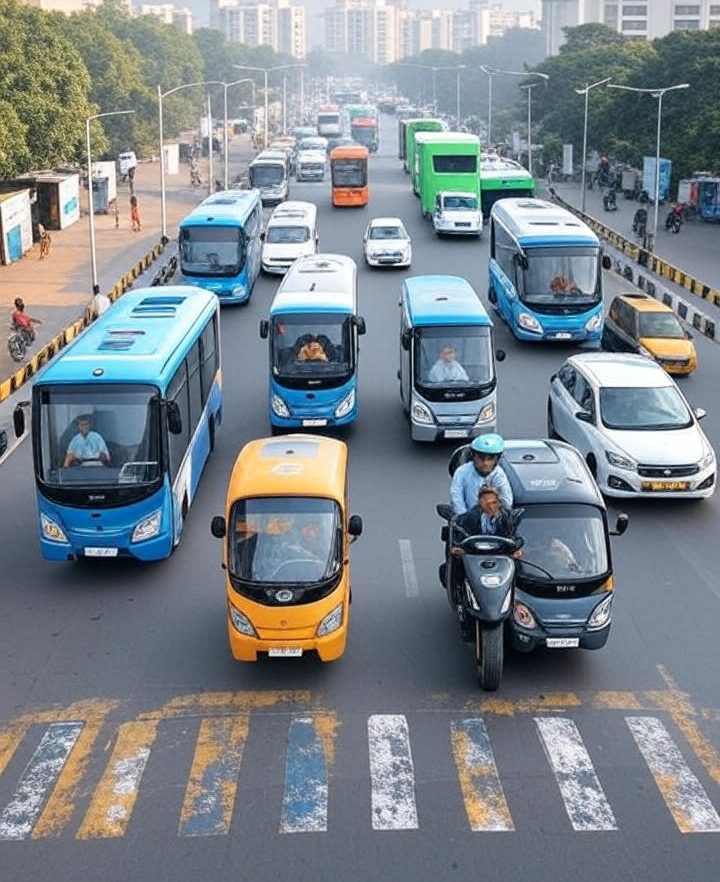
Introduction
India’s commercial vehicle (CV) market is undergoing a transformative shift, driven by the rapid adoption of electric vehicles (EVs). Fueled by government initiatives, rising environmental consciousness, and technological advancements, the EV sector is reshaping the landscape of commercial transportation. From electric buses revolutionizing public transit to electric three-wheelers dominating last-mile delivery, the CV market is thriving as it embraces sustainable mobility. This blog explores the recent trends, policies, challenges, and opportunities propelling India’s CV market toward a greener future, with a focus on EV adoption.
The Rise of Electric Vehicles in India’s Commercial Sector
India’s commercial vehicle market, encompassing buses, trucks, three-wheelers, and light commercial vehicles (LCVs), is a critical component of the nation’s economy. The sector supports logistics, public transportation, and e-commerce, contributing significantly to GDP. In recent years, the push for electrification has gained momentum, driven by the need to reduce carbon emissions, combat urban air pollution, and decrease reliance on imported fossil fuels, which account for nearly 80% of India’s crude oil needs.
In 2024, India’s EV market achieved a significant milestone, with total EV sales surpassing 2 million units, reflecting a 24% year-on-year (YoY) growth and an 8% market share, up from 6.8% in 2023. Within the commercial vehicle segment, electric three-wheelers, buses, and light commercial vehicles are leading the charge. The commercial vehicle segment, while currently holding a smaller share compared to two-wheelers, is projected to experience substantial growth from 2024 to 2029, driven by increasing demand for electric buses and delivery vehicles.
Key Drivers of EV Adoption in Commercial Vehicles
Segment-Wise Trends in EV Adoption
Electric Three-Wheelers
Electric three-wheelers (e-3Ws) are a cornerstone of India’s CV market, particularly in the passenger and cargo segments. In 2024, e-3Ws sold 694,466 units, with the cargo segment experiencing a remarkable 45% YoY growth, driven by the logistics and e-commerce sectors. Mahindra Last Mile Mobility leads the market with a 10% share in the passenger segment and 11% in the cargo segment, while Bajaj Auto recorded an impressive 1,290% YoY growth in the e-3W cargo segment.
The popularity of e-3Ws stems from their affordability, maneuverability in congested urban areas, and lower operating costs. Government incentives under FAME-II and the PM E-DRIVE scheme have further supported their adoption. Additionally, battery-swapping solutions, offered by companies like Sun Mobility and Battery Smart, are addressing range anxiety and reducing downtime for commercial operators.
Electric Buses
Electric buses are transforming public transportation in India, with sales reaching 3,834 units in 2024, a 39% YoY increase. The PM eBus Sewa scheme aims to deploy 60,000 electric buses nationwide, with 7,000 already sanctioned for intracity operations. Cities like Delhi, which plans to transition 80% of its bus fleet to electric by 2025, are leading the way.
Companies like PMI Electro Mobility, JBM Auto, and Olectra Greentech dominate the e-bus market. The PM E-DRIVE scheme’s focus on public transit electrification, combined with lower operating costs and environmental benefits, is expected to accelerate e-bus adoption in major cities.
Electric Light Commercial Vehicles (LCVs)
Electric LCVs, including delivery vans and small trucks, are gaining traction due to their suitability for urban logistics. The segment benefits from predictable usage patterns, lower maintenance costs, and the rise of low-emission zones in cities. Mahindra & Mahindra plans to launch eight battery electric LCVs by 2027, targeting the growing demand for zero-emission logistics solutions.
Fuel Cell Electric Vehicles (FCEVs)
The FCEV segment is emerging as the fastest-growing category in India’s CV market, with a projected growth rate of 85% from 2024 to 2029. FCEVs offer longer ranges and faster refueling times, making them ideal for heavy-duty applications like long-haul trucking. Omega Seiki Mobility’s partnership with Hydrogen Intelligence SA to manufacture green hydrogen-powered small commercial vehicles, including three-wheelers and one-tonne trucks, is a notable development.
Key Players Driving the Market
Several companies are leading the charge in India’s electric CV market:
- Tata Motors: With over 36% market share in electric passenger vehicles, Tata Motors is a dominant player, extending its expertise to commercial EVs like buses and LCVs.
- Mahindra & Mahindra: A pioneer in the EV space, Mahindra leads in e-3Ws and is expanding its LCV portfolio with plans for eight new BEVs by 2027.
- Ola Electric: Known for its electric two-wheelers, Ola is also making inroads into the e-3W market, leveraging its technological expertise and charging network.
- Ather Energy: While primarily focused on two-wheelers, Ather’s charging infrastructure supports commercial EV adoption.
- PMI Electro Mobility, JBM Auto, and Olectra Greentech: These companies are key players in the electric bus segment, benefiting from government-backed schemes.
Challenges to EV Adoption in the Commercial Sector
Despite the progress, several challenges hinder widespread EV adoption in India’s CV market:
- High Upfront Costs: EVs are typically 20–30% more expensive than their ICE counterparts, posing a barrier for small fleet operators.
- Inadequate Charging Infrastructure: While the number of charging stations has increased, India still lags behind countries like Taiwan, which has nearly twice as many battery-swapping stations. A Confederation of Indian Industry (CII) report estimates that India needs 1.32 million charging stations by 2030 to support EV growth.
- Supply Chain Constraints: India’s reliance on imported components and batteries increases costs and limits localization.
- Policy Uncertainty: The potential reduction of subsidies under the forthcoming FAME-III scheme could impact future growth.
- Range Anxiety: Limited driving range and insufficient charging infrastructure in Tier-2 cities and rural areas deter adoption, particularly for long-haul applications.
Opportunities for Growth
The challenges are significant, but the opportunities in India’s electric CV market are immense:
- Infrastructure Expansion: Investments in charging and battery-swapping infrastructure, supported by government and private sectors, are critical. The PM E-DRIVE scheme and initiatives like JSW MG Motor’s eHUB app are streamlining charging processes.
- Technological Innovation: Advances in battery management systems, fast-charging technology, and hydrogen fuel cells are making EVs more practical. Patents related to battery efficiency and powertrains are driving innovation.
- Fleet Electrification: The commercial sector’s high utilization rates make EVs economically attractive. Fleet operators, especially in e-commerce, are increasingly adopting EVs to reduce operating costs.
- Job Creation: The EV industry is expected to create 10 million direct jobs and 50 million indirect jobs by 2030, boosting economic growth.
- Export Potential: With initiatives like Make in India, India aims for 100% local EV production, positioning the country as a global EV manufacturing hub.
Government’s Vision and Policy Support
India’s government has set ambitious targets for EV adoption, aiming for 70% penetration in commercial vehicles by 2030. Key initiatives include:
- FAME-II and PM E-DRIVE: These schemes provide subsidies and infrastructure support, focusing on public and shared transportation.
- National Electric Bus Programme: Aiming to deploy 60,000 e-buses, this program is transforming urban mobility.
- Battery Swapping Policy: NITI Aayog’s draft policy, valid until March 2025, promotes battery swapping in metropolitan cities, enhancing convenience for commercial operators.
- Tax Benefits: A tax deduction of up to INR 1.5 lakh under section 80EEB and reduced customs duties on battery components encourage adoption.
Regional Leadership in EV Adoption
South India, particularly states like Karnataka, Tamil Nadu, and Telangana, is leading EV production and adoption. Cities like Bengaluru, Chennai, and Hyderabad are hubs for EV manufacturing and innovation, supported by progressive state policies and investments. For instance, VinFast’s USD 2 billion EV project in Thoothukudi, Tamil Nadu, aims to produce 150,000 units annually. Uttar Pradesh leads in e-3W sales, while Karnataka and Maharashtra dominate two- and four-wheeler segments.
Future Outlook
India’s electric CV market is poised for exponential growth, with projections indicating a market size of USD 110.74 billion by 2029, driven by a CAGR of 19.44%. The commercial vehicle segment is expected to play a pivotal role, with electric buses and LCVs gaining traction in urban and logistics applications. The FCEV segment, with its 85% growth projection, holds promise for heavy-duty transport.
To achieve the 2030 target of 70% EV penetration in commercial vehicles, India must address infrastructure gaps, reduce costs through localization, and maintain policy consistency. Collaborations between government, OEMs, and private players will be crucial in scaling production and infrastructure. The success of e-commerce giants adopting EVs for last-mile delivery and the expansion of e-bus fleets in cities signal a bright future for the sector.
Conclusion
India’s commercial vehicle market is thriving with the rapid adoption of electric vehicles, driven by supportive policies, economic incentives, and technological advancements. While challenges like high costs and limited infrastructure persist, the opportunities for growth are vast. With a focus on sustainability, innovation, and infrastructure development, India is well-positioned to become a global leader in electric commercial vehicles, paving the way for a cleaner, greener future.









